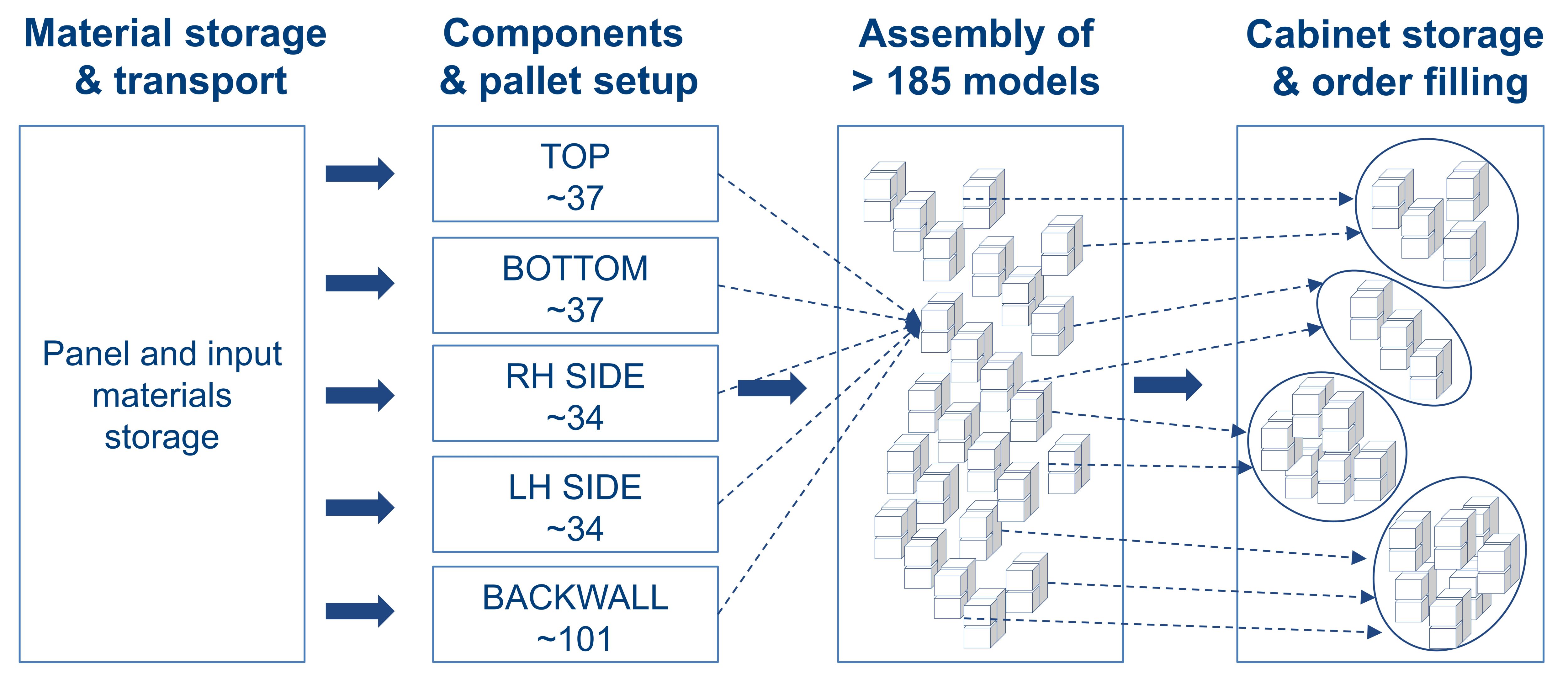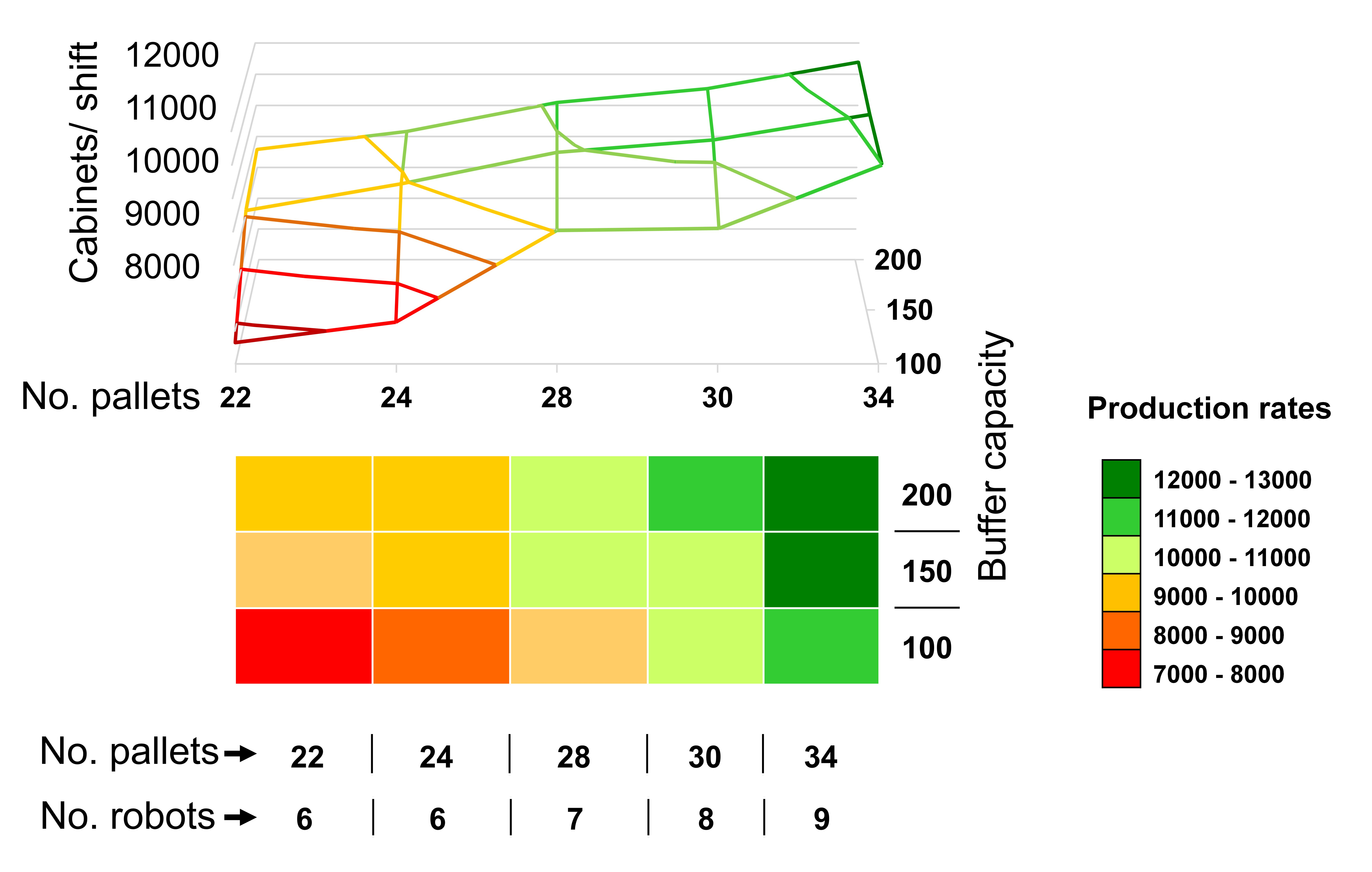ANZINE : CAE 기술 매거진
이전 ANZINE Home Case Study
[Global] Flexible factory design and reconfiguration using digital simulation models
- Anteneh Teferi Yemane
- EnginSoft
- a.yemane@enginsoft.com
Flexible factory design and reconfiguration
using digital simulation models
By Anteneh Teferi Yemane | EnginSoft
Mirko Piasentin, Thomas Bickl, Enrico Favero | Tecno Logica
Published in Futurities Year 21 n°3 by EnginSoft
■ Abstract
본 원고는 생산 시스템에서 짧아진 제품 수명 주기와 증가하는 맞춤형 수요에 적응하기 위한 유연한 디지털 시뮬레이션 모델의 중요성을 소개합니다. 특히 맞춤형 주방 캐비닛 주문을 효율적으로 처리하기 위해 다양한 제품을 다루면서도 생산 효율을 유지할 수 있는 로봇 조립 라인을 설계한 솔루션 사례를 다룹니다. 주요 도전 과제는 가동 중단 시간 최소화와 생산 과정의 잦은 변경을 최적화를 통해 방지하는 것이며, 디지털 시뮬레이션 접근법을 기반으로 단계별 솔루션을 통해 다음과 같은 성과를 도출했습니다.
• 투자 리스크를 줄이고,
• 자원 활용과 생산 흐름을 최적화하며,
• 초기 단계에서 잠재적 문제를 식별해 설계 시간을 단축했습니다.
이 시뮬레이션 모델은 운영 관리를 지원하여 생산 수명 주기 전반에서 효율성을 높이는 데 기여합니다. 본 원고가 관련 산업 종사자분들께 유용한 인사이트를 제공할 수 있기를 기대합니다.
In today's rapidly changing industrial landscape, the complexity and demands of factory design and reconfiguration are greater than ever. To cope with shorter product lifecycles and increased demand for customization, manufacturers need to maximize the flexibility, reconfigurability and adaptability of system capacity.

Fig.1. Part flow simulation model of the configuration of a physical asset.
Traditional design and reconfigurations methods, which rely on simplified models and calculations, often involve many challenges, including inefficiency, high costs, and inflexibility.
Digital simulation models are one of the most powerful tools to overcome these limitations, enabling companies to design and test efficient and cost-effective production systems before irreversible capital investments are made during physical development. Their importance cannot be overstated in helping companies to stay competitive and innovative in a rapidly changing market.
Some of the main advantages of digital simulation models include:
- Accurate and robust designs reduce the need for costly trial-and-error methods and enable rapid adjustments to meet changing demand.
- Save time by accelerating design and decision-making processes, resulting in faster time-to-market for new products.
- Virtual prototyping – companies can visualize the entire factory layout, anticipating potential issues early in the design process and refining them before physical implementation.
- Simplified production planning allows for quicker adjustments and refinements, ensuring that production schedules are met more efficiently.
- The use of real-time data improves predictive analysis capabilities, leading to better forecasts and more informed decisions.
■ An industrial application of digital simulation: designing a furniture assembly factory
This section presents an example of a digital simulation model successfully applied to support factory design. The customer is a manufacturer of pre-assembled kitchen furniture modules ready for installation in end-customer kitchens. The production system must be able to fully assemble each type of furniture specified in an order before shipping the full set of kitchen cabinets to the end-customer.
These orders are highly customized, with each kitchen design being uniquely based on the end-customer’s requirements, using a combination of over 185 pieces of furniture and different colour options.
This scenario posed the challenge of designing a production line to efficiently handle a high variety of products. System integrator Tecno Logica was requested by the cabinet manufacturer to design and install a robotic, cabinet assembly line able to guarantee a target production rate while efficiently handling the high variety of products. The design teams were tasked with quickly creating a layout configuration to meet the requirements and to optimize investment and resource efficiency by virtually validating the designs before proceeding to award the contract and its development.
■ Factory design requirements
The layout design consists of the following areas and operations (see Fig.2):
- Panel storage area
- Shuttle for transporting material between the panel storage area and the bays
- Pallets for positioning panels in the bays
- Robots for removing the panels from the pallets and loading them onto the carousels
- Automated carousels to process the panels and assemble them into cabinets
- Buffer area for storing finished cabinets waiting for delivery to the customer

Fig.2. Diagram of the layout showing the main processes.
Customer orders consist of a mix of cabinet types and all types must be completed before orders can be shipped, otherwise the finished cabinets must wait in storage until the missing cabinets are produced, taking up valuable space in the final buffer area. When this situation occurs, the production line is forced to stop for a production change to make the missing cabinet types.
To reduce downtime from buffer blockages and frequent production changes, two macro requirements were defined:
- Group similar orders using an algorithm so that more cabinets can be produced in the same batch before switching to a different type.
- Improve system flexibility by:
- increasing the number of pallets to allow more types of panels to be produced simultaneously, reducing the frequency of downtime to change cabinet type;
- creating sufficient buffer capacity to store enough cabinets without blocking the production line, while remaining within the acceptable limit available to the factory
The challenge was to provide a digitally simulated and validated solution with the optimal configuration of shuttles, pallets, robots and buffer size before building the physical system.
■ Simulation development, study and optimization
For brevity, we have skipped the order clustering algorithm and will proceed to describe the digital simulation construction process, consisting of 1) problem formalization, 2) simulation implementation, 3) validation, and 4) optimization. Lastly, selected optimal solutions are further studied and presented.
1. Formalization of the problem and objectives
This phase prioritizes the challenges, and collects and organizes the information (divided into four areas, see Fig.3) to quantitatively model and formulate strategies to calculate the simulation objectives. The following dataset was collected in discussion with Tecno Logica and the cabinet manufacturer who ordered the production line.
- Data on process flows, resources, cycle times.
- Example data on full order types and the quantities of cabinets.
The expected results of the simulation were production rate, equipment utilization, and efficiency KPIs.

Fig.3. Diagram of material flow and data collected for simulation.
2. Implementation of the detailed simulation engine
A discrete event simulation (DES) model was developed to mimic key behaviours affecting product flow. For example, how the shuttle picks up panels from storage and loads them onto pallets, how pallets are exchanged in bays, how robots load panels onto carousels, etc.
The DES model allows the current layout performance to be simulated based on historical production order output and export performance statistics, e.g. production rate, percentage of orders completed, robot utilization, shuttle, etc. In addition to the simulation model, an intelligent order aggregation and production planning algorithm was developed and used to sequence production based on intelligent aggregation of customer orders to improve production performance. Dashboards, animations and visualizations were integrated to facilitate understanding of system behaviour and part flow, and to summarize and report important KPIs. The DES model was built using SIMUL8 (see Fig.4).

Fig.4. Discrete event simulation model created with Simul8.
3. Testing and validation of simulation with test cases
This step verifies that the simulation accurately reflects the behaviour of the real system. It verifies the rules for order grouping, scheduling, production, storage, and shipping to the customer (see Fig.5). It also checks whether the production equipment acted in the specified sequences and whether the subsystems interacted as expected. An extensive experimental campaign is conducted using the DES engine with dummy scenarios to validate the simulation.

Fig.5. Test procedures applied to the modules of the simulation model

The results and feedback from these experiments are shared with Tecno Logica to refine the accuracy of the model and to consolidate the final version to be used for optimization and study.
4. Optimization of pallet bays and buffer configurations of cabinets
After the simulation had been tested and validated, it was submitted to an optimization algorithm to find the best bay and cabinet buffer configurations. Optimization was performed using historical order logs and target production rates to investigate both the optimality and robustness of the configurations.
Sensitivity analysis, performed by simulating varying conditions around the optimal configurations, statistically validated the results. The 3D graphs and heat map in Fig.6 show the optimization workflow, configurations, and associated production performance as a function of the number of pallets, robots and buffer capacities. Green configurations met or exceeded target performance; red and yellow had below target performance. Each configuration had an associated investment cost that was further assessed by Tecno Logica before it made its final choice of the best layout. The entire study was completed in six weeks, allowing Tecno Logica to present the analysis results in a timely manner to the cabinet manufacturer who finally approved the physical development of the system.

Fig.6. Simulation model submitted to workflow optimization (L), and performance of configurations (R).
Conclusions
• Using digital simulation models during the design phase reduces investment risks arising from inaccurate and rigid designs by planning efficient adaptation strategies for changes in product type and production volumes.
• By incorporating simulation models into optimization algorithms, resources are optimized on configurations that require less capital investment.
• Parametric simulation models reduce design and development time by identifying and resolving potential errors during the virtual validation process.
• Design phase simulation models can be adapted into simulation models for operational management to support operational efficiency throughout the production system’s lifecycle.
 Homepage
Homepage
Tecno Logica was founded in 1998 by Mirko Piasentin to meet the need for industrial automation and robotic solutions. It became a highly qualified partner for major industrial groups in solving complex engineering problems and developing production processes for machining, assembly stations, and testing machines. Tecno Logica is registered in the Italian National Register of Research Laboratories to develop competitive methods at multiple levels: to reduce production costs, target innovation in production processes, and to work with products with unique quality characteristics that may be developed and co-funded by public grants. It is an ISO:9001 certified enterprise. Since 2024 Tecno Logica has been part of Scm Group, a world leader in processing a wide variety of materials: wood, plastic, glass, stone, metal and composites.
For more information:
Anteneh Teferi Yemane – EnginSoft
a.yemane@enginsoft.com








 ㈜태성에스엔이
㈜태성에스엔이


